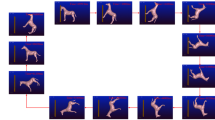Abstract
The simplest approach to quantifying animal behavior begins by identifying a list of discrete behaviors and observing the animal’s behavior at regular intervals for a specified period of time. The behavioral distribution (the fraction of observations corresponding to each behavior) is then determined. This is an incomplete characterization of behavior, and in some instances, mild injury is not reflected by statistically significant changes in the distribution even though a human observer can confidently and correctly assert that the animal is not behaving normally. In these circumstances, an examination of the sequential structure of the animal’s behavior may, however, show significant alteration. This contribution describes procedures derived from symbolic dynamics for quantifying the sequential structure of animal behavior. Normalization procedures for complexity estimates are presented, and the limitations of complexity measures are discussed.



Similar content being viewed by others
References
Braida D, Paladini E, Griffini P, Lamperti M, Maggi A, Sala M (1996) An inverted U-shape curve for heptylphysostigmine on radial maze performance in rats: comparison with other cholinesterase inhibitors. Eur J Pharmacol 302(1–3):13–20
Ebeling W, Jiménez-Montaño MA (1980) On grammars, complexity and information measures of biological macromolecules. Math Biosci 52:53–71
Lempel A, Ziv J (1976) On the complexity of finite sequences. IEEE Trans Inform Theory IT-22:75–81
Neumeister H, Cellucci CJ, Rapp PE, Korn H, Faber DS (2004) Dynamical analysis reveals individuality of locomotion in goldfish. J Exp Biol 207:697–708
Paulus MP, Geyer MA (1992) The effects of MDMA and other methylenedioxy-substittued phenylalkylamines on the structure of rat locomotor activity. Neuropsychopharmacology 7:15–31
Paulus MP, Geyer MA (1993) Quantitative assessment of the microstructure of rat behavior: I. f(d), the extension of the scaling hypothesis. Psychopharmacology 113:177–186
Paulus MP, Geyer MA, Gold LH, Mandell AJ (1990) Application of entropy measures derived from the ergodic theory of dynamical systems to rat locomotor behavior. Proc Natl Acad Sci 87:723–727
Paulus MP, Callaway CW, Geyer MA (1993) Quantitative assessment of the microstructure of rat behavior: II. Distinctive effects of dopamine releasers and uptake inhibitors. Psychopharmacology 113:187–198
Paulus MP, Geyer MA, Braff DL (1996) Use of methods from chaos theory to quantify a fundamental dysfunction in the behavioral organization of schizophrenic patients. Am J Psychiatry 153:714–717
Picciotto MR (2003) Nicotine as a modulator of behavior: beyond the inverted U. Trends Pharmacol Sci 24(9):493–499
Rapp PE, Schmah TI (1996) Complexity measures in molecular psychiatry. Mol Psychiatry 1:408–416
Rapp PE, Schmah TI (2000) Dynamical analysis in clinical practice. In: Lehnertz K, Arnhold J, Grassberger P, Elger CE (eds) Chaos in brain? World Scientific, Singapore, pp 52–65
Rapp PE, Jiménez-Montanó MA, Langs RJ, Thomson L (1991) Quantitative characterization of patient-therapist communication. Math Biosci 105:207–227
Rapp PE, Albano AM, Schmah TI, Farwell LA (1993) Filtered noise can mimic low dimensional chaotic attractors. Phys Rev 47E:2289–2297
Rapp PE, Albano AM, Zimmerman ID, Jiménez-Montaño MA (1994) Phase-randomized surrogates can produce spurious identifications of non-random structure. Phys Lett 192A:27–33
Rapp PE, Cellucci CJ, Korslund KE, Watanabe TAA, Jiménez-Montaño M-A (2001) An effective normalization of complexity measurements for epoch length and sampling frequency. Phys Rev 64E:016209-1–016209-9
Rapp PE, Cellucci CJ, Watanabe TAA, Hernandez RS (2004) Time dependent measures of dynamical complexity. In: Benigni R, Colosimo A, Giuliani A, Sirabella P, Zbilut J (eds) Proceedings of complexity in the living, Rome, 2004. http://w3.uniromal.it/cisb/complexity. Accessed 8 Oct 2007
Rapp PE, Cellucci CJ, Watanabe TAA, Albano AM (2005) Quantitative characterization of the complexity of multichannel human EEGs. Int J Bifurcat Chaos 15:1737–1744
Theiler J, Eubank S, Longtin A, Galdrikian B, Farmer JD (1992) Testing for nonlinearity in time series: the method of surrogate data. Physica 58D:77–94
Watanabe TAA, Cellucci CJ, Kohegyi E, Bashore TR, Josiassen RC, Greenbaun NN, Rapp PE (2003) The algorithmic complexity of multichannel EEGs is sensitive to changes in behavior. Psychophysiology 40:77–97
Zernig G, Wakonigg G, Madlung E, Haring C, Saria A (2004) Do vertical shifts in dose-response rate relationships in operant conditioning procedures indicate “sensitization” to “drug wanting”? Psychopharmacology 171(3):349–351
Acknowledgments
This research was supported by the Naval Medical Research Center. I also acknowledge support from the Traumatic Injury Research Program of the Uniformed Services University. The opinions and assertions contained herein are the private ones of the authors and are not to be construed as official or reflecting the views of the Navy Department or the naval service at large.
Author information
Authors and Affiliations
Corresponding author
Rights and permissions
About this article
Cite this article
Rapp, P.E. Quantitative characterization of animal behavior following blast exposure. Cogn Neurodyn 1, 287–293 (2007). https://doi.org/10.1007/s11571-007-9027-8
Received:
Accepted:
Published:
Issue Date:
DOI: https://doi.org/10.1007/s11571-007-9027-8




